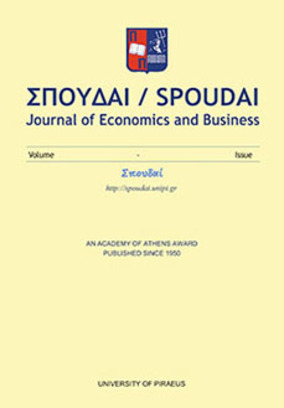European Monetary Union and Foreign Direct Investment inflows
Part of : Σπουδαί : journal of economics and business ; Vol.62, No.1-2, 2012, pages 47-55
Issue:
Pages:
47-55
Abstract:
The aim of this paper is to construct and test a model explaining the inward Foreign Direct In - vestment (FDI) position of various members of European Monetary Union (EMU), on the basis of their location advantages during 1980-2010 period. The model focuses on the impact of EMU on FDI inflows and indicates that the monetary union has differentiated impact on FDI inflows across individual member countries. Euro zone membership is statistically significant but a negative determinant in the cases of Greece, Portugal, France, Belgium and Spain. Furthermore, for both Germany and Ireland the Euro area membership is a negative but statistically insignificant FDI inflow factor, while in the cases of Netherlands and Finland it is positive but also statistically insignificant. The results imply that countries with low competitiveness have not gained from the entrance in European Monetary Union, in terms of Foreign Direct Investment inflows.
Subject (LC):
Keywords:
FDI, EMU, euro
Notes:
Περιέχει πίνακα, διαγράμματα, σημειώσεις και βιβλιογραφία
References (1):
- Aristotelous, K., 2005. Do currency unions affect foreign direct investment? Evidence from USFDI flows into the European Union. Economic Issues. 10. pp. 1-10.Aristotelous, K. and Fountas, S., 2009. What is the impact of currency unions on FDI flows? Evidencefrom Eurozone countries. Discussion Paper No 11/2009. Department of Economics.University of Macedonia.Brouwer, J.R. Paap. and Viaene, J-M., 2008. The trade and FDI effects of EMU enlargement.Journal of International Money and Finance. 27. pp. 188-208.Buckley, P.J. and Casson, M.C., 1981. The Optimal Timing of Foreign Direct Investment. EconomicJournal. 91. pp. 75-87.Caves, R.E., 1982. “Multinational enterprise and economic analysis”. Cambridge University Press.New York.Clegg, J. and Scott-Green, S.C., 1999. The determinants of new foreign direct investment capitalflows into the European community: A statistical comparison of the USA and Japan. Journalof Common Market Studies. 374. pp. 597-616.Culem, C.J., 1988. The Locational Determinants of Direct Investments among Industrialised Countries.European Economic Review. 324. pp. 885-904.Dunning, J.H., 1977. “Trade location of economic activity and the multinational enterprise: a searchfor an eclectic approach”. In B. Ohlin, P.O. Hesselborn and P.M. Wijkman eds. “The InternationalAllocation of Economic Activity. Macmillan. London.Dunning, J.H., 1988a. “Explaining International Production”. Harper Collins. London.Dunning, J.H., 1993. Multinational enterprises and the global economy. Wokingham: AddisonWesley.Markusen, J.R. and Venables, A.J., 1998. Multinational firms and the new trade theory. Journalof International Economics. 46:2. pp. 183-203.Meyer, K., 1998. Direct investment in economies in transition. Massachusetts. Edward Elgar Publishing.Petroulas, P., 2006. The effect of the euro on FDI. Working Paper. No 48. Oct. 2006. Bank of Greece.Rose, A., 2004. A Meta-Analysis of the effect of Common Currencies on International Trade. EconomicPolicy. 30. pp. 9-45.Scaperlanda, A.E. and Mauer, L.J., 1969. The Determinants of US Direct Foreign Investment inthe EEC. American Economic Review. 593. pp. 558-568.Scaperlanda, A.E. and Mauer, L.J., 1972. The Determinants of US Direct Foreign Investment inthe EEC: Reply. American Economic Review. 624. pp. 700-704.Souca, J. and Lochard, J., 2011. Does the single currency affect foreign direct investment? TheScandinavian Journal of Economics. Vol. 113, Issue 3, pp. 553-578. 2011 Hymer, S.H., 1960.The international operations of National firms: a study of direct foreign investment. MITpress. Cambridge. MA.Vernon, R., 1966. International investment and international trade in the product cycle. QuarterlyJournal of Economics. 80. pp. 190-207.




